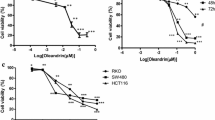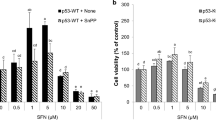Abstract
Diallyl disulfide (DADS), one of the major organosulfur compounds of garlic, is recognized as a group of potential chemopreventive compounds. In this study, we examines the early signaling effects of DADS on human colorectal cancer cells SW480 loaded with Ca2+-sensitive dye fura-2. It was found that DADS caused an immediate and sustained rise of [Ca2+]i in a concentration-dependent manner (EC50 = 232 μM). DADS also induced a [Ca2+]i elevation when extracellular Ca2+ was removed, but the magnitude was reduced by 45%. Depletion of intracellular Ca2+ stores with 2 μM carbonylcyanide m-chlorophenylhydrazone, a mitochondrial uncoupler, didn’t affect DADS’s effect. In Ca2+-free medium, the DADS-induced [Ca2+]i rise was abolished by depleting stored Ca2+ with 1 μM thapsigargin (an endoplasmic reticulum Ca2+ pump inhibitor). DADS-caused [Ca2+]i rise in Ca2+-containing medium was not affected by modulation of protein kinase C activity. The DADS-induced Ca2+ influx was blocked by nicardipine (10 μM). U73122, an inhibitor of phospholipase C, abolished ATP (but not DADS)-induced [Ca2+]i rise. These findings suggest that DADS induced a significant rise in [Ca2+]i in SW480 colon cancer cells by stimulating both extracellular Ca2+ influx and thapsigargin-sensitive intracellular Ca2+ release via as yet unidentified mechanisms.





Similar content being viewed by others
References
Annunziato L, Amoroso S, Pannaccione A, Cataldi M, Pignataro G, D’Alessio A, Sirabella R, Secondo A, Sibaud L, Di Renzo GF (2003) Apoptosis induced in neuronal cells by oxidative stress: role played by caspases and intracellular calcium ions. Toxicol Lett 139:125–133
Blaustein MP (1988) Calcium transport and buffering in neurons. Trends Neurosci 11:438–443
Chakraborti T, Das S, Mondal M, Roychoudhury S, Chakraborti S (1999) Oxidant, mitochondria and calcium: an overview. Cell Signal 11:77–85
Chen CY, Li YW, Kuo SY (2009) Effect of [10]-gingerol on [Ca2+]i and cell death in human colorectal cancer cells. Molecules 14:959–969
Chen CY, Yang YH, Kuo SY (2010) Effect of [6]-shogaol on cytosolic Ca2+ levels and proliferation in human oral cancer cells (OC2). J Nat Prod 73:1370–1374
Clapham DE (1995) Calcium signaling. Cell 80:259–268
Das A, Banik NL, Ray SK (2007) Garlic compounds generate reactive oxygen species leading to activation of stress kinases and cysteine proteases for apoptosis in human glioblastoma T98G and U87MG cells. Cancer 110:1083–1095
Filomeni G, Aquilano K, Rotilio G, Ciriolo MR (2003) Reactive oxygen species-dependent c-JunNH2-terminal kinase/c-Jun signaling cascade mediates neuroblastoma cell death induced by diallyl disulfide. Cancer Res 63:5940–5949
Goldhaber JI, Qayyum MS (2000) Oxygen free radicals and excitation-contraction coupling. Antioxid Redox Signal 2:55–64
Grynkiewicz G, Poenie M, Tsien RY (1985) A new generation of Ca2+ indicators with greatly improved fluorescence properties. J Biol Chem 260:3440–3450
Hong YS, Ham YA, Choi JH, Kim J (2000) Effects of allyl sulfur compounds and garlic extract on the expression of Bcl-2, Bax, and p53 in non small cell lung cancer cell lines. Exp Mol Med 32:127–134
Hussain SP, Jannu LN, Rao AR (1990) Chemopreventive action of garlic on methylcholanthrene-induced carcinogenesis in the uterine cervix of mice. Cancer Lett 49:175–180
Jacobsen WK, Schell RM, Matsumura JS, Cole DJ, Stier GR, Martin RD, Fandrich BL (1994) Nitrendipine and superoxide dismutase in ischemic renal injury. Ren Fail 16:697–705
Jan CR, Ho CM, Wu SN, Huang JK, Tseng CJ (1998) Mechanism of lanthanum inhibition of extracellular ATP-evoked calcium mobilization in MDCK cells. Life Sci 62:533–543
Jan CR, Chen CH, Wang SC, Kuo SY (2005) Effect of methylglyoxal on intracellular calcium levels and viability in renal tubular cells. Cell Signal 17:847–855
Jemal A, Siegel R, Ward E, Murray T, Xu J, Thun MJ (2007) Cancer statistics. CA Cancer J Clin 57:43–66
Karmakar S, Banik NL, Patel SJ, Ray SK (2007) Garlic compounds induced calpain and intrinsic caspase cascade for apoptosis in human malignant neuroblastoma SH-SY5Y cells. Apoptosis 12:671–684
Knowles LM, Milner JA (2001) Possible mechanism by which allyl sulfides suppress neoplastic cell proliferation. J Nutr 131:1061S–1066S
Kuo SY, Ho CM, Chen WC, Jan CR (2003a) Sulfhydryl Modification by 4, 4′-dithiodipyridine induces calcium mobilization in human osteoblast-like cells. Arch Toxicol 77:630–637
Kuo SY, Jiann BP, Lu YC, Chang HT, Chen WC, Huang JK, Jan CR (2003b) Thiol oxidation by 2,2′-dithiodipyridine induced calcium mobilization in MG63 human osteosarcoma cells. Life Sci 72:1733–1743
Kwon KB, Yoo SJ, Ryu DG, Yang JY, Rho HW, Kim JS, Park JW, Kim HR, Park BH (2002) Induction of apoptosis by diallyl disulfide through activation of caspase-3 in human leukemia HL-60 cells. Biochem Pharmacol 63:41–47
Liao QJ, Su J, He J, Song Y, Tang HL, Su Q (2009) Effect of diallyl disulfide on cell cycle arrest of human colon cancer SW480 cells. Ai Zheng 28:138–141
Lin HL, Yang JS, Yang JH, Fan SS, Chang WC, Li YC, Chung JG (2006) The role of Ca2+ on the DADS-induced apoptosis inmouse-rat hybrid retina ganglion cells (N18). Neurochem Res 31:383–393
Ma Y, Hendershot LM (2004) The role of the unfolded protein response in tumour development: friend or foe? Nat Rev Cancer 4:966–977
McFadzean I, Gibson A (2002) The developing relationship between receptor-operated and store-operated calcium channels in smooth muscle. Br J Pharmacol 135:1–13
Milner JA (1996) Garlic: its anticarcinogenic and antitumorigenic properties. Nutr Rev 54:S82–S86
Montell C (2005) The latest waves in calcium signaling. Cell 122:157–163
Nakagawa H, Tsuta K, Kiuchi K, Senzaki H, Tanaka K, Hioki A, Tsubura A (2001) Growth inhibitory effects of diallyl disulfide on human breast cancer cell lines. Carcinogenesis 22:891–897
Orrenius S, Zhivotovsky B, Nicotera P (2003) Regulation of cell death: the calcium-apoptosis link. Nat Rev Mol Cell Biol 4:552–565
Park EK, Kwon KB, Park KI, Park BH, Jhee EC (2002) Role of Ca2+ in diallyl disulfide induced apoptotic cell death of HCT-15 cells. Exp Mol Med 34:250–257
Putney JW (1986) A model for receptor-regulated calcium entry. Cell Calcium 7:1–12
Robert V, Mouillé B, Mayeur C, Michaud M, Blachier F (2001) Effects of the garlic compound diallyl disulfide on the metabolism, adherence and cell cycle of HT-29 colon carcinoma cells: evidence of sensitive and resistant sub-populations. Carcinogenesis 22:1155–1161
Sakamoto K, Lawson LD, Milner JA (1997) Allyl sulfides from garlic suppress the in vitro proliferation of human A549 lung tumor cells. Nutr Cancer 29:152–156
Sundarm SG, Milner JA (1996) Diallyl disulfide induces apoptosis of human colon tumor cells. Carcinogenesis 17:669–673
Thastrup O, Cullen PT, Drobak BK, Hanley MR, Dawson AP (1990) Thapsigargin, a tumor promotor, discharges intracellular calcium stores by specific inhibition of the endoplasmic reticulum calcium ATPase. Proc Natl Acad Sci USA 87:2466–2470
Thompson AK, Mostafapour SP, Denlinger LC, Bleasdale JE, Fisher SK (1991) The aminosteroid U73122 inhibits muscarinic receptor sequestration and phosphoinositide hydrolysis in SK-N-SH neuroblastoma cells. J Biol Chem 266:23856–23862
Vaur S, Sartor P, Dufy-Barbe L (2000) Calcium store depletion induced by mitochondrial uncoupling in prostatic cells. Gen Physiol Biophys 19:265–278
Wang H, Joseph JA (2000) Mechanisms of hydrogen-induced calcium dysregulation in PC12 cells. Free Radic Biol Med 28:1222–1231
Weinberg JM, Venkatachalam MA (1991) Role of calcium channel blockers in protection against experimental renal injury. Am J Med 90:21S–26S
Wu CC, Sheen LY, Chen HW, Tsai SJ, Lii CK (2001) Effects of organosulfur compounds from garlic oil on the antioxidation system in rat liver and red blood cells. Food Chem Toxicol 39:563–569
Wu CC, Sheen LY, Chen HW, Kuo WW, Tsai SJ, Lii CK (2002) Differential effects of garlic oil and its three major organosulfur components on the hepatic detoxification system in rats. J Agric Food Chem 50:378–383
Yang JS, Chen GW, Hsia TC, Ho HC, Ho CC, Lin MW, Lin SS, Yeh RD, Ip SW, Lu HF, Chung JG (2009) Diallyl disulfide induces apoptosis in human colon cancer cell line (COLO 205) through the induction of reactive oxygen species, endoplasmic reticulum stress, caspases casade and mitochondrial-dependent pathways. Food Chem Toxicol 47:171–179
Zhang Y, Soboloff J, Zhu Z, Berger SA (2006) Inhibition of Ca2+ influx is required for mitochondrial reactive oxygen species-induced endoplasmic reticulum Ca2+ depletion and cell death in leukemia cells. Mol Pharmacol 70:1424–1434
Acknowledgments
This work was supported by grants from National Science Council (NSC93-2311-B-242-002) to Kuo SY.
Author information
Authors and Affiliations
Corresponding author
Rights and permissions
About this article
Cite this article
Chen, CY., Huang, CF., Tseng, YT. et al. Diallyl disulfide induces Ca2+ mobilization in human colon cancer cell line SW480. Arch Toxicol 86, 231–238 (2012). https://doi.org/10.1007/s00204-011-0748-4
Received:
Accepted:
Published:
Issue Date:
DOI: https://doi.org/10.1007/s00204-011-0748-4




